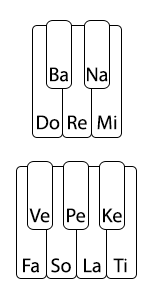Shapes
Independent Solfege
Listen
Transcript
As you’ve been adding different moods, you’ve also been collecting all the different tensions together along with the neutral mood.
And now we’re going drop the tonescape away, so you’re listening to just the tensions on their own, like this [demo].
This means you’re no longer listening in the context of any one mood, and you’ll no longer have the feeling that some of the tensions are inside or outside of the mood. Instead, you can start to really focus on the tensions themselves—on each tension’s unique feeling of pull to the anchor, and on the potential each tension has to imply different moods.
The challenge when when you listen without the tonescape is staying oriented to the anchor. You already have some practice doing this, but if you lose track of the anchor, a good technique is to stop and listen until you hear the anchor again, and then continue from there.
You might at this point also start to have the experience of recognizing one of the other tensions, even if you haven’t heard the anchor. This might happen out in the world, too— you hear a horn honk, or the microwave beeps, and it feels like a fifth, or a light 3rd—a particular tension to a phantom anchor.
But what we don’t have yet, is a way to name notes independently from their relationship to an anchor note.
For example, when you press a key on the keyboard, the position of the key itself distinguishes it from the other keys. And the note that key represents has the potential to become the anchor note, or any tension to a different anchor note.
But when we move away from the keyboard, like when we’re just listening, it really helps to have names that identify notes in this same way, independently from their relationship to an anchor note.
You can do this with a naming system called Independent Solfege. It gives each note its own independent name, just like a key on the keyboard, that doesn’t change depending on the note’s context.
You might already recognize several of these independent note names. On the keyboard, the three bottom notes that surround a group of two top notes are called Do, Re, and Mi, and the four bottom notes that surround a group of three top notes are called Fa, So, La, and Ti.
The two top notes themselves are Ba and Na, and the three top notes are Ve, Pe, and Ke.

Each of these names starts with a different letter of the alphabet, and each ends with a vowel sound, so it’s easy to sing.
In the tonescape exercises, we’ve been using the note Re for our anchor note in all of the moods. This means, using Independent Solfege names, the heavy 2nd is Na, the light 2nd is Mi, the heavy 3rd is Fa, the light 3rd is Ve, the 4th is So, the light 4th or heavy 5th is Pe, the 5th is La, the heavy 6th is Ke, the light 6th is Ti, the heavy 7th is Do, and the light 7th is Ba.
The second tonescape exercise replaces the tension names with Independent Solfege names. So you’ll still hear each note as a tension to the anchor, but if you recognize, say, a heavy 3rd, you’ll name it as Fa, instead of “heavy 3rd.”
This might take some practice, first to get used to holding on to the anchor without the tonescape, and then to get to know the Independent Solfege names.
But once you do, you’ll be all set up to shift your attention and hear a different note as the anchor note, and then name the other notes in relation to that new anchor.
So, for example, I’ve been hearing Re as the anchor, and Fa as a heavy 3rd. But if I reorient myself to hear Fa as the anchor [sing], then I can still recognize the sound of a heavy 3rd [sing], but now Pe is the note that has this relationship to the anchor.
So now you have two different kinds of names. One that describes a relationship to the anchor, and one that describes the note itself, independent of any relationship.
These names work together to describe the notes you hear in different and complementary ways. And of course, they also give you a way to connect what you hear back to what you play on the keyboard.
So give it a try, and when you’ve started to get the hang of naming tensions without the tonescape, and of using Independent Solfege names, that’s when you’re ready to come back for more.
Tonescape Exercises
All Notes, Tension Names
All Notes, Independent Solfege Names